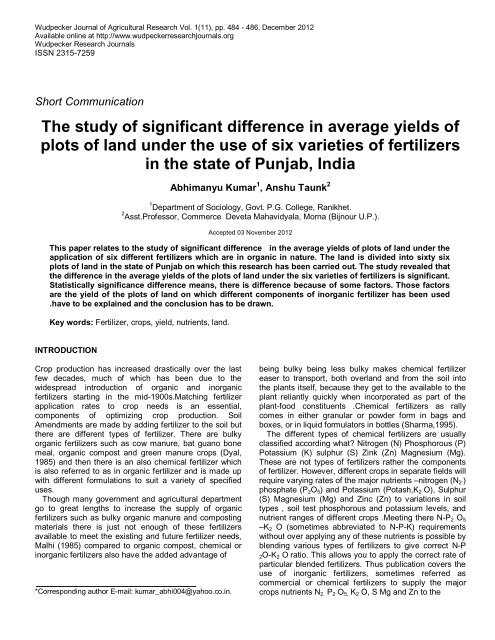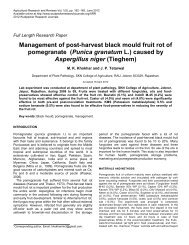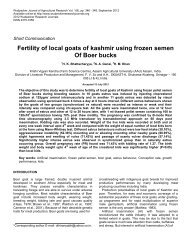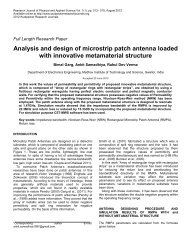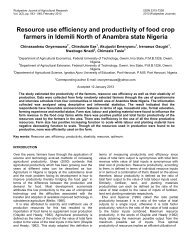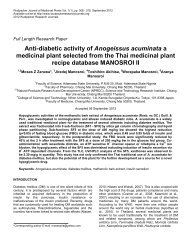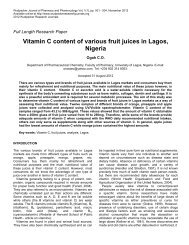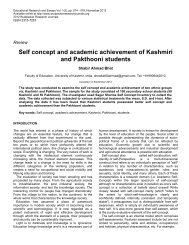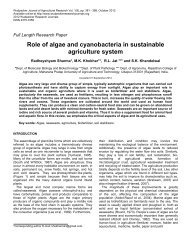Reprint (PDF) - Wudpecker Research Journals
Reprint (PDF) - Wudpecker Research Journals
Reprint (PDF) - Wudpecker Research Journals
You also want an ePaper? Increase the reach of your titles
YUMPU automatically turns print PDFs into web optimized ePapers that Google loves.
<strong>Wudpecker</strong> Journal of Agricultural <strong>Research</strong> Vol. 1(11), pp. 484 - 486, December 2012<br />
Available online at http://www.wudpeckerresearchjournals.org<br />
<strong>Wudpecker</strong> <strong>Research</strong> <strong>Journals</strong><br />
ISSN 2315-7259<br />
Short Communication<br />
The study of significant difference in average yields of<br />
plots of land under the use of six varieties of fertilizers<br />
in the state of Punjab, India<br />
Abhimanyu Kumar 1 , Anshu Taunk 2<br />
1 Department of Sociology, Govt. P.G. College, Ranikhet.<br />
2 Asst.Professor, Commerce Deveta Mahavidyala, Morna (Bijnour U.P.).<br />
Accepted 03 November 2012<br />
This paper relates to the study of significant difference in the average yields of plots of land under the<br />
application of six different fertilizers which are in organic in nature. The land is divided into sixty six<br />
plots of land in the state of Punjab on which this research has been carried out. The study revealed that<br />
the difference in the average yields of the plots of land under the six varieties of fertilizers is significant.<br />
Statistically significance difference means, there is difference because of some factors. Those factors<br />
are the yield of the plots of land on which different components of inorganic fertilizer has been used<br />
.have to be explained and the conclusion has to be drawn.<br />
Key words: Fertilizer, crops, yield, nutrients, land.<br />
INTRODUCTION<br />
Crop production has increased drastically over the last<br />
few decades, much of which has been due to the<br />
widespread introduction of organic and inorganic<br />
fertilizers starting in the mid-1900s.Matching fertilizer<br />
application rates to crop needs is an essential,<br />
components of optimizing crop production. Soil<br />
Amendments are made by adding fertilizer to the soil but<br />
there are different types of fertilizer. There are bulky<br />
organic fertilizers such as cow manure, bat guano bone<br />
meal, organic compost and green manure crops (Dyal,<br />
1985) and then there is an also chemical fertilizer which<br />
is also referred to as in organic fertilizer and is made up<br />
with different formulations to suit a variety of specified<br />
uses.<br />
Though many government and agricultural department<br />
go to great lengths to increase the supply of organic<br />
fertilizers such as bulky organic manure and composting<br />
materials there is just not enough of these fertilizers<br />
available to meet the existing and future fertilizer needs,<br />
Malhi (1985) compared to organic compost, chemical or<br />
inorganic fertilizers also have the added advantage of<br />
*Corresponding author E-mail: kumar_abhi004@yahoo.co.in.<br />
being bulky being less bulky makes chemical fertilizer<br />
easer to transport, both overland and from the soil into<br />
the plants itself, because they get to the available to the<br />
plant reliantly quickly when incorporated as part of the<br />
plant-food constituents .Chemical fertilizers as rally<br />
comes in either granular or powder form in bags and<br />
boxes, or in liquid formulators in bottles (Sharma,1995).<br />
The different types of chemical fertilizers are usually<br />
classified according what Nitrogen (N) Phosphorous (P)<br />
Potassium (K) sulphur (S) Zink (Zn) Magnesium (Mg).<br />
These are not types of fertilizers rather the components<br />
of fertilizer. However, different crops in separate fields will<br />
require varying rates of the major nutrients –nitrogen (N 2 )<br />
phosphate (P 2 O 5 ) and Potassium (Potash,K 2 O), Sulphur<br />
(S) Magnesium (Mg) and Zinc (Zn) to variations in soil<br />
types , soil test phosphorous and potassium levels, and<br />
nutrient ranges of different crops .Meeting there N-P 2 O 5<br />
–K 2 O (sometimes abbreviated to N-P-K) requirements<br />
without over applying any of these nutrients is possible by<br />
blending various types of fertilizers to give correct N-P<br />
2O-K 2 O ratio. This allows you to apply the correct rate of<br />
particular blended fertilizers. Thus publication covers the<br />
use of inorganic fertilizers, sometimes referred as<br />
commercial or chemical fertilizers to supply the major<br />
crops nutrients N 2, P 2 O 5, K 2 O, S Mg and Zn to the
485 <strong>Wudpecker</strong> J. Agric. Res.<br />
coursing crop yields (Singh, 1990).<br />
However, some such test in the country has suggested<br />
different doses of N P K for crop yield under different soil<br />
conditions (Mallick et al., 1985; Dyal and Mishra, 1985;<br />
Malhi and Nijjar, 1985). The present studies on the<br />
fertilizers requirements on plots of land to the<br />
corresponding yield of crops were carried out in the state<br />
of Punjab. However, chemical fertilizers alone generate<br />
several deleterious effects to the environment and human<br />
health and they should be replenished in every cultivation<br />
season because, the synthetic N, P and K fertilizer is<br />
rapidly lost by either evaporation or by leaching in<br />
drainage water and it causes dangerous environmental<br />
pollution (Aisha et al., 2007). Continuous usage of<br />
inorganic fertilizer affects soil structure. Hence, organic<br />
manures can serve as alternative to mineral fertilizers as<br />
reported by Naeem et al. (2006) for improving soil<br />
structure (Ouda, 2008) and microbial biomass (Suresh et<br />
al., 2004).<br />
Akoun (2004) confirmed that organic manure increases<br />
the nutrient status of a soil which leads to increase in<br />
onion yield. Generally N, P and K uptakes were<br />
significantly higher in both organically and inorganically<br />
fertilized plants than their unfertilized counterparts<br />
(Babajide et al., 2008). The role of nutrients is one of<br />
paramount importance in booting productivity and quality<br />
of onion which is a heavy feeder of mineral elements and<br />
continuous use of inorganic fertilizers resulted in<br />
deficiency of micronutrients, imbalance in soil<br />
physicochemical properties and unsustainable crop<br />
production (Jeyathilake et al., 2006).<br />
As a result, farmers are currently changing from<br />
conventional to organic farming systems which used no<br />
synthetic fertilizers and pesticides (Abbey, 2004). It is due<br />
to the continuous increase of prices of synthetic<br />
chemicals in the world market.<br />
Hypothesis<br />
Null hypothesis<br />
H 0 : There is no significant difference in the average yields<br />
under the six varieties of fertilizes.<br />
Objective<br />
1. To Study the average yields of plots of land.<br />
2. To investigate whether there is significant difference in<br />
the average yields under the six varieties of fertilizes.<br />
RESEARCH METHODOLOGY<br />
The northern states of Punjab, Haryana and Uttar Pradesh (western<br />
districts) represent India’s granary and contribute greatly to the<br />
wheat reserves of the country. Field experiments on six varieties of<br />
fertilizers on the wheat (cv. PBW-138 suited for late-sown<br />
conditions and cv. HD-2329, a high yielding variety also often<br />
adapted for late-sown conditions). The test soil was a sandy loam<br />
Typic Ustochrept low in available N and organic carbon (0.34<br />
percent) and medium in available P (22 kg/ha) and K (136 kg/ha).<br />
Wheat was sown late (January 6), thereby establishing a higher<br />
plant population than obtained with the, which encompasses the<br />
fertile Indo- Gangetic alluvial plain, is capable of producing above<br />
average wheat yields.<br />
Thus each plots of land consisted of 0.5 hectares. All collected<br />
data were statistically analyzed by analysis of variance using the<br />
Statistic Analysis System (SAS) software package. Treatment<br />
means that were significantly different were compared using<br />
Fishers test at 5% level.<br />
Selecting fertilizer and method of applications<br />
Phosphate, Magnesium, Sulphur, Zinc and K 2O can be land-applied<br />
at any time, but normally it is more cost-effective to apply at the<br />
same time as N. However, N is more mobile than P 2O 5 and K 2O in<br />
the soil and should be applied as closely as possible to the time of<br />
crop uptake. Nitrogen in the form of nitrate can be lost from soils via<br />
leaching and can be denitrified to N gas in reducing conditions,<br />
such as soils saturated with water. Recommended dosage of<br />
Inorganic Fertilizers (IF) as a control [Urea (100 kg ha -1 ), Triple<br />
Super Phosphate (100 kg ha -1 ) and Muriate of Potash (50 kg ha -1 ).<br />
RESULTS AND DISCUSSION<br />
It was found that there were significant (P
Kumar and Taunk 486<br />
Table 1. Yield (quintal) on sixty six plots of land in six samples, each of 11 plots, under six varieties of fertilizers.<br />
S.N. Nitrogen(N) Phosphorous(P) Potassium(K) Sulphur(S) Zinc(Zn) Magnesium(Mg)<br />
X 1 X 2 X 3 X 4 X 5 X 6<br />
1 18 19 21 22 28 24<br />
2 21 26 23 32 23 30<br />
3 23 28 24 34 21 32<br />
4 25 21 25 30 24 34<br />
5 27 31 21 31 28 26<br />
6 29 30 20 29 23 24<br />
7 31 29 19 27 27 22<br />
8 32 33 17 28 29 21<br />
9 19 18 18 20 24 18<br />
10 17 19 22 24 26 19<br />
11 20 22 26 21 30 27<br />
Total ∑X 1 =262 ∑X 2 =276 ∑X 3=236 ∑X 4=298 ∑X 5 =283 ∑X 6 =277<br />
Mean ∑X 1/n= 23.81 ∑X 2/n= 25.09 ∑X 3/n= 21.45 ∑X 4/n= 27.09 ∑X 5/n= 25.72 ∑X 6/n= 25.18<br />
App =24 =25 =21 =27 =26 =25<br />
Grand mean (Ẋ) =24.66=25(Round off)<br />
Table 2. Analysis of variance (ANOVA).<br />
Source of Sum of Degrees of Mean<br />
variation<br />
squares(SS) freedom(d.f.) squares (MS)<br />
Between samples 132 5 26.4<br />
Within samples 1326 60 22.1<br />
65=N-1<br />
Test statistics<br />
F=26.4/22.1=1.194<br />
Mean square within the samples (MSW) = 1326/γ 2<br />
=1326/60=22.1<br />
F (test) = MSB/MSW=26.4/22.1=1.194<br />
Conclusion<br />
This experiment demonstrated the effects of different<br />
levels of inorganic fertilizers in the yield of crop. Inorganic<br />
fertilizer treated plants quick growth rate and good yield.<br />
From the results of this investigation, it was found that<br />
there was of significant difference in the average yields<br />
of plots of land under the application of six different<br />
fertilizers which is inorganic in nature. From the table<br />
given above the value of F for γ 1 =5 and γ 2 =60 at 5%<br />
level is 2.37. We see that the calculated value 1.194 is<br />
smaller than the tabulate value 2.37. Hence, we accept<br />
the null hypothesis at 5% level and conclude that the<br />
difference in the average yields of the plots of land under<br />
the six varieties of fertilizers is significant.<br />
REFERENCES<br />
Aisha AH, Rizk FA, Shaheen AM, Abdel-Mouty MM (2007). Onion plant<br />
growth, bulbs yield and its physical and chemical properties as affected<br />
by organic and natural fertilization. Res. J. Agric. and Biol. Sci., 3(5):<br />
380-388.<br />
Akoun J (2004). Effect of plant density and manure on the yield and yield<br />
components of the common onion (Allium cepa L.) var. nsukka red. Nig.<br />
J. Horticultural Sci., 9: 43-48.<br />
Dyal K, Mishra SL (1985). In: Second lnt. Symposium on Mango, India,<br />
Abst., 4(3): 30.<br />
Jeyathilake PKS, Reddy IP, Srihari D, Reddy KR (2006). Productivity and<br />
soil fertility status as influenced integrated use of N-fixing Biofertilizers,<br />
organic manures and inorganic fertilizers in onion. J. Agric. Sci., 2(1):<br />
46-58.<br />
Malhi CS (1982). Ph. D. Thesis, PAU., Ludhiana<br />
Malhi CS, Nijjar GS (1985). In: Second Int. Symposium on Mango, India.<br />
Abst., 4(1): 29.<br />
Mallick SK , Susanta Kumar (1985). In: Second Int. Symposium on Mango,<br />
India. Abst. 4(19): 37.<br />
Naeem M, Iqbal J, Bakhsh MAA (2006). Comparative study of inorganic<br />
fertilizers and organic manures on yield and yield components of<br />
mungbean (Vigna radiate L.). J. Agric. and Soc. Sci., 2: 227-229.<br />
Ouda BA, Mahadeen AY (2008). Effect of fertilizers on growth, yield, yield<br />
components, quality and certain nutrient contents in broccoli (Brassica<br />
oleracea). Int. J. Agric. and Boil., 10(6): 627-632.<br />
Singh RN (1990). In: Mango (Ed. R.M. Singh) I.C.A.R, New Delhi, pp. 66-<br />
73.<br />
Tindall HD (1968). Commercial Vegetable growing. Tropical hand book<br />
series, Oxford University Press. Oxford. pp 635-637.<br />
Abbey L, Kanton RAL (2004). Fertilizer type, but not time of cessation of<br />
irrigation, affect onion development and yield in a semi arid region. J.<br />
Vegetable crop prod., 9(2): 41-48.


